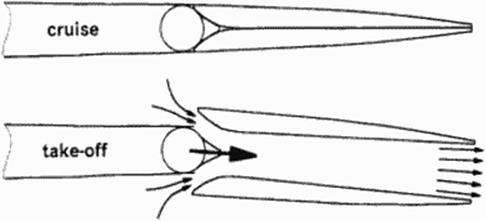Ejector Flaps
A new SCT. especially a Concorde-type SCT, has difficulties to fulfill take-off noise requirements. Any possibility to improve take-off performance and reduce noise must therefore be investigated.
The engine companies have proposed several engine types for SCT. There are engines which provide so much high pressure air at take-off. that they can only apply full (thermal) power if a large amount of bleed air is used elsew here It is worth, therefore, to investigate ejee – lor flaps (Figure 34). mainly 10 increase thrust Problems lo be investigated are:
• What is the efficiency of the complex tubing and ejector flap system ?
• Docs the additional installation weight of the complex tubing and flap system offset the improvement of take-off performance?
• How complex and reliable will the system be?
• What is the noise of such an ejector system?
• Will exploitation of the ejector system for lift generation improve the design, w hen trim penalties and safety requirements arc respected?
|
|
Figure 34 Ejector Flaps
To estimate the pros and cons of such a system, probably an SCT optimized without ejector flaps must be compared with a completely independent optimum design which is adapted to the exploitation of the ejector flaps
5.8 Conclusion
A new SCT will only become reality, if many technologies are unproved or newly developed. Some of them are aerodynamic technologies, as mentioned above. But many of them require contributions by other disciplines or need interdisciplinary’ connection with others Both pure aerodynamics and interdisciplinary problems provide enough opportunities for many new intelligent contributions.















